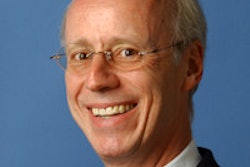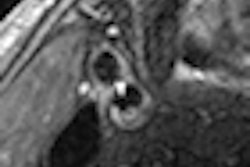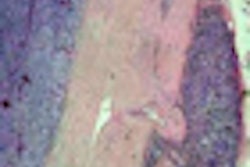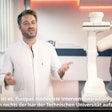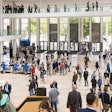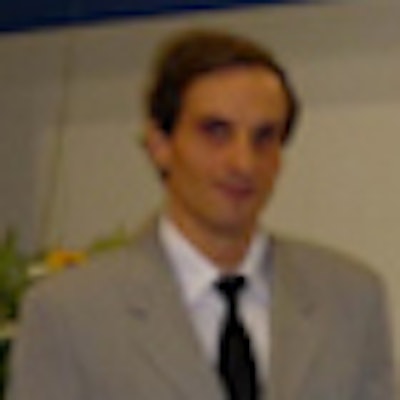
As part of AuntMinnieEurope.com's wrap-up from the German-Austrian national congress (Deutscher Röntgenkongress, DRK), two first-time attendees present their thoughts from the meeting in Hamburg, which ended on Saturday.
A successful congress
by Dr. Martin Hüllner
As a first-time participant of the German-Austrian Radiology joint congress (Deutscher Röntgenkongress, DRK), I was curious about the quality of the scientific sessions and the teaching lectures. I was also excited about the atmosphere at the new venue, the Congress Center Hamburg. This place is located in a large recreational park, within walking distance to the city center. It is easy to reach by Hamburg's public transport network, as there are a railway station and several underground stations (in Hamburg named "Hochbahn") close to the center.
 Dr. Martin Hüllner at the registration table for the German National Congress.
Dr. Martin Hüllner at the registration table for the German National Congress.The center itself provides a lot of space, so it does not immediately come to your mind you are part of almost 8,000 congress attendees. Due to an effective organization with state-of-the-art online registration and fast check-in lanes you do not usually have to queue at registration desks. Several participants including me were a little bit disappointed that the venue did not offer a general public wireless LAN connection. There was wireless LAN access only in the students' lounge if you knew the password -- for the forthcoming congress in 2012 there is a high likelihood the password will be "studentenlounge2012."
Being a speaker in scientific sessions, I had the opportunity to compare Hamburg with other congresses such as the ECR in Vienna. The session rooms were well-equipped, and I did not experience any technical problems. The size of the rooms is slightly smaller than in Vienna; however, the number of audience members is comparable. More modern than at ECR, you sign in at sessions and lectures with your badge electronically (no more barcode stickers!), and the title of the session and the current talk are displayed outside the rooms on flat panels. The vast majority of scientific talks are in German, but there is also the possibility to submit and speak in English. The scientific standard of these talks is comparable to those at ECR. Teaching lectures are generally held in German. These lectures focus on refreshing radiological knowledge, but there is also a series of lectures designed for residents preparing for the national board exams.
 The Hamburg congress center is located in a large recreational park, within walking distance to the city center. Image courtesy of Dr. Martin Hüllner.
The Hamburg congress center is located in a large recreational park, within walking distance to the city center. Image courtesy of Dr. Martin Hüllner.One of the highlights of this year's program was the keynote lecture on expert differential diagnosis in the brain, held by Dr. Anne Osborn on Friday morning. The great hall, which accommodates 1,000 persons, had to be closed due to overcrowding. Another highlight, which emphasizes the reality of the congress' program (and of radiology itself as a clinical specialty), was the instant addition of a lecture on brain lesions in E. coli patients, held by Dr. B. Eckart and Dr. J. Fiehler. The ongoing E. coli epidemic with Hamburg as a hotspot was also topic of many conversations, both during the congress and in the evenings.
The congress administration advised catering services to refrain from offering fresh vegetables. Besides that, there was not much public commotion in Hamburg. I did not notice restaurants changing their menu, although I have heard from my colleagues that some restaurants were temporarily not offering cucumber and tomato salads. To my knowledge, none of the congress members got infected.
In my opinion, both the scientific exchange and the atmosphere in Hamburg were successful.
Dr. Martin Hüllner is from the department of radiology and nuclear medicine at Lucerne Cantonal Hospital in Lucerne Switzerland.
'Radiology is variety!'
by Dr. Petra Siebenhandl
With this slogan the 92nd German Congress of Radiology took place in Hamburg for the first time. Due to the fact, that this article is written by a person who visited the German Congress of Radiology for the first time, it is a first impression and no comparison with former events.
First of all, the slogan kept its promise. There were a variety of different aspects of radiology: lectures about interventional radiology, experimental radiology, and lectures about the newest facilities and techniques of MRI, CT, and PET/CT, as well as mammography. Topics for example such as dual-source CT of the heart and the newest MRI techniques to image the heartbeat were attracting many auditors. Interventional therapies for locoregional cancer, transarterial chemoembolization (TACE) for example, were presented with the newest updates. More specific articles on pediatric radiology, neuroradiology, and topics of the head and neck also found a great audience. The congress has been a convention of the greatest radiologists of Europe, who showed their results in research in many different parts of radiology.
Due to the fact that Hamburg, with its freshness of sea breeze, hosted the congress for the first time, the organizers were observed specifically. But in summary, there was no disappointment. They did a great job, and the freshness of the city was well-reflected at the congress.
Hamburg, with its huge harbor and lake in the middle of the city, offers a great variety of leisure activities. Sitting at the riverside and watching the sunset is probably the best way to let the day die away after a successful event at the lectures at the Congress Center Hamburg.
In the exhibition hall, there were lots of different companies, partly familiar faces but also newcomers with innovative ideas and high technology in a very comfortable ambience, where they also took care of your physical well-being.
Carestream Health was giving helpful suggestions in productivity, cost containment, time saving, and cost efficiency for clinicians and finally simplifing the workflows. One of the most important technologies in the future is the new cloud-based eHealth portal service, which allows access to data by any authorized user anywhere, anytime through a simple Internet connection. This could provide a replacement to CDs and printing, and facilitate and accelerate the treatment of patients.
Altogether, it was a perfect combination of interesting lectures and opportunities for social networking in one of the most beautiful cities in Germany.
Dr. Petra Siebenhandl is a radiologist at the Institut für Diagnostische und Interventionelle Radiologie, Klinikum der Johann Wolfgang Goethe, Frankfurt am Main.
The comments and observations expressed herein do not necessarily reflect the opinions of AuntMinnieEurope.com, nor should they be construed as an endorsement or admonishment of any particular vendor, analyst, industry consultant, or consulting group.
You can read more about the DRK here.




